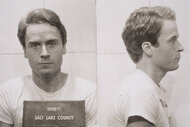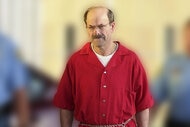Create a free profile to get unlimited access to exclusive videos, breaking news, sweepstakes, and more!
The Serial Killer Next Door: The Shocking True Story Of Dennis Rader, The BTK Killer
Dennis Rader was described as a good father, loving husband and faithful churchgoer before people learned the truth about his BTK slayings.
Murders A-Z is a collection of true crime stories that take an in-depth look at both little-known and famous murders throughout history.
A good father. A loving husband. A faithful churchgoer. A friendly neighbor. This is how the people who knew Dennis Rader would have described him before they learned the truth. Before they learned that for years he had been keeping a closet full of secrets. Before they learned that he had a deadly obsession with bondage and S&M. Before they learned that between 1974 and 1991, he killed 10 people. Before they learned he was the infamous BTK Killer, with the initials BTK standing for his self-professed modus operandi — Bind, Torture, Kill.
Who Is BTK Killer Dennis Rader?
Prior to his arrest in February 2005, no one would have taken Dennis Lynn Rader for a deviant serial killer. Born on March 9, 1945, the oldest of four brothers, he grew up in Wichita, Kansas. He had an average childhood, but claimed he became obsessed with bondage pornography at an early age and admitted strangling cats and dogs for kicks. As a teenager he was a “Peeping Tom” and would steal women’s underwear.
In 1966, Rader joined the US Air Force, where he spent the next four years working as a mechanic, including periods stationed overseas. Upon his return to Wichita, he married Paula Dietz, with whom he had two children — a boy, Brian, and a girl, Kerri.
To support his family in the early ‘70s, Rader worked on an assembly line at Coleman, a company that employs many in Wichita. Another Coleman employee was Julie Otero, a 33-year-old mother of five. Rader began stalking her and spying on her family and also became infatuated with Otero’s 11-year-old daughter, Josephine. On the morning of January 15, 1974, he forced his way inside their family home, but was surprised to find Julie’s husband Joseph, 38, and their 9-year-old son, Joseph Jr., still at home.
Rader later testified, "After I got in the house, I lost control of it. But it was, you know, in the back of my mind I had some ideas of what I was going to do."
He then held the family at gunpoint, tied them up and strangled them one by one. After killing Mr. and Mrs. Otero and their son, he took Josephine Otero down to the basement, pulled down her pants and underwear and hung her. After she was dead, he masturbated — leaving crucial DNA evidence behind at the scene — took a radio and Mr. Otero’s wristwatch as keepsakes and walked out the front door.
Two-and-a-half months later, Rader struck again. He had seen 21-year-old Kathryn Bright going into her house one day and decided to make her one of his “projects” or “PJs,” as he liked to call his potential victims. Coincidentally, she also worked at the Coleman plant. On April 4, 1974, Rader broke into her home while she was out and waited for her to return. When she did, however, she was with her 19-year-old brother Kevin. While Rader held them at gunpoint and had them tie each other up, both Bright siblings tried to fight off their attacker. He ended up shooting Kevin, who got away and survived, and fatally stabbed Kathryn 11 times in the torso and back.
"She fought like a hellcat," he later told detectives.
In October 1974, Don Granger, who served on the editorial board of The Wichita Eagle newspaper, received an anonymous phone call telling him there was a letter hidden inside a mechanical engineering textbook at the Wichita Public Library. It was filled with poor grammar and misspellings, but it described the Otero killings in detail, saying, “When this monster enter my brain I will never know. But, it here to stay.” At the bottom, it was signed, “YOURS, TRULY GUILTILY,” adding in its post-script, “The code words for me will be… Bind them, Torture them, Kill them, B.T.K., you see be at it again. They will be on the next victim.”
The newspaper gave the letter to the Wichita Police Department, who kept it secret for months. Cathy Henkel, a reporter for the rival Wichita Sun, later received a copy of the letter from an unnamed source.
"I felt at that time, and still do, that the public had a right to know this guy was still out there and stalking his victims," Henkel told the Wichita Eagle in 2004. On December 11, 1974, The Sun published a story about the letter, putting Wichita on notice they had a serial killer on their hands.
What Did Dennis Rader Do For A Living?
Ironically, at the same time that his hometown was looking over its collective shoulders in fear, Rader was installing alarm systems in homes and businesses for ADT Security Services. With a killer on the loose, business was booming. He was not, however, popular with his co-workers.
"None of us liked him,” work colleague Ron Sparkman later told The Wichita Eagle. "He wasn't the kind of guy you wanted to get a beer with after work."
After going quiet for several years, Rader struck twice in 1977. On March 17, 1977, he forced his way inside the home of 24-year-old Shirley Vian, tied her up, put a plastic bag over her head and strangled her with a rope. Her three young children were home at the time, locked in the bathroom. Rader had intended to kill them, too, but he left in a hurry after Vian’s phone began ringing.
On December 8, 1977, he broke into the apartment of 25-year-old Nancy Fox after cutting her phone lines and making sure she wasn’t home. When she returned from work, he confronted her. He handcuffed her and strangled her with a belt. After killing her, he masturbated, stole her driver’s license as a memento, tidied up the crime scene and later called police to report the murder from a downtown payphone. In February 1978, he sent a two-page letter to KAKE-TV, claiming responsibility for the Vian and Fox murders.
Rader wouldn’t kill again for over seven years. During that time, he earned a bachelor's degree in criminal justice from Wichita State University, another grim irony. He became an active member of Wichita’s Christ Lutheran Church and was at one point was even elected president of the congregation’s council. His daughter, Kerri Rawson, would later describe him as a good father, and he was a Scout Leader with his son’s Boy Scout troop.
The BTK Killer would brazenly revive his murderous ways on April 27, 1985, when he targeted Marine Hedge, 53, who lived just up the street from the Rader family. As usual, he broke into her home and hid there when she came home with her boyfriend. After the boyfriend left and Hedge got into bed, Rader jumped out of the darkness and strangled her with his bare hands. He then brought her nude body to Christ Lutheran Church, where he posed her in various bondage positions and took photographs of her before hastily burying her in a ditch.
Rader changed his methodology on September 16, 1986, when he dressed up as a telephone repairman and knocked on the door of 28-year-old Vicki Wegerle. She let him in and he pulled a gun on her. Her 2-year-old son Brandon was home at the time. He tried to tie her up, but she fought back. He ended up choking her with a nylon stocking. He then took photographs of her corpse and stole her car. Vicki’s husband, Bill Wegerle, claimed he was driving when he saw a stranger behind the wheel of his wife’s car before getting home and discovering her dead on the floor.
The BTK Killer’s tenth and final victim was 62-year-old Dolores E. Davis. Rader was on a Boy Scout camping trip on January 19, 1991, when he said he left something at home. Instead, he drove to Davis’ home and threw a concrete block through a plate glass window to gain entry. After tying her up, he strangled her with a pair of pantyhose. He later hid her body underneath a bridge outside of town before returning to the campsite.
On the 30th anniversary of the Otero murders in early 2004, The Wichita Eagle ran a piece about the still unsolved case of the BTK Killer. Soon after, the newspaper received a letter from “Bill Thomas Killman,” which contained a photocopy of Vicki Wegerle's driver's license and photos from the crime scene. This began a series of communications with local media and police, 11 in all, with Rader sending various pieces of evidence and autobiographical writings.
How Did Dennis Rader Get Caught?
In February 2005, Rader sent police a message, asking, “Can I communicate with Floppy (disc) and not be traced to a computer. Be honest.”
Police responded as he asked, placing an ad in a local paper saying, "Rex, it will be OK." On the floppy disk, which Rader sent to Wichita’s KSAS-TV, police were able to retrieve metadata from a deleted document that had been last modified by “Dennis” on a computer at Christ Lutheran Church. This circumstantial evidence linked Dennis Rader to the BTK murders. Police then secretly obtained his daughter’s DNA from a recent pap smear, which closely matched semen samples found at the crime scenes and skin found under Vicki Wegerle's fingernails.
Just after noon on February 25, 2005, Dennis Rader was returning home for lunch from his job as a town compliance officer when he was surrounded by police and taken into custody.
Police asked him if he knew why he was being arrested, and he replied, “Oh, I have suspicions why.”
Rader eventually confessed to being The BTK Killer, sharing details of the killings and telling detectives where they could find evidence in his “hidey holes,” scattered throughout Wichita.
“We couldn’t shut him up,” Wichita Kansas Police Lieutenant Ken Landwehr later said.
Where Is Dennis Rader Today?
On June 27, 2005, Dennis Rader pleaded guilty to 10 counts of first-degree murder and he later received the maximum sentence of 10 consecutive life terms. He is currently incarcerated at the maximum-security El Dorado Correctional Facility near Wichita, where he is being held in solitary confinement for his own safety. He is allowed five one-hour periods per week out of his 80-square-foot cell.
He was recently eyed as a person of interest in the investigation into the disappearance of 16-year-old Cynthia "Cyndi" Dawn Kinney, who went missing in 1976. However, Rader said that he has an alibi for the day she was last seen.
"The sheriff has what I call complete lack of solid evidence," Rader told Fox News Digital.
His daughter, Kerri, told the outlet she doesn't believe her father was involved in Kinney's disappearance. "While it is my hope and prayer this missing person cold case gets solved for the family and friends of Kinney, in no way do I believe my father is connected. And, in fact, I believe he’s telling the truth on this, as he has done since 2005 on the 10 he did commit," she explained.
(This story was originally published on September 20, 2018 and has been updated with new information.)






























